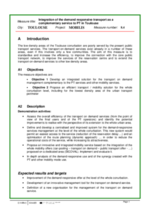Integrating a demand-responsive public transportation service
Summary
Since only a few communities in low-density areas of the Toulouse conurbation had access to transport-on-demand services, the measure aimed to standardise and extend the service.
Implementing sustainable mobility
Toulouse has a very wide urban public transport perimeter, comprising 95 towns and villages, in which average population density is very low. Such areas tend to be poorly served by public transport as they are unable to justify the operation of a regular bus line. At the end of the 1990s, the public transport authority created a demand-responsive service, provided by taxi for the same price as a public transport journey. This was introduced on bus lines where there were fewer than three passengers per hour in off-peak periods. In 2004, there were five transport-on-demand lines operating in the Toulouse conurbation, served by taxi-bus, each with its own booking service. The CIVITAS measure was launched in response to the need to fully integrate this service into the public transport offer and to increase and standardise efficiency and improve connections with other services.
The specific goals were to:
- develop an integrated solution for the management of transport on demand, complementary to public transport and other mobility services;
- propose an efficient transport/mobility solution for the whole conurbation, including for the lowest density areas of the urban transport perimeter; and
- develop and implement new flexible demand-responsive public transport services for low-density areas and low-traffic periods, in connection to the most important intermodal nodes.
Progress
Activities included:
- assessing the overall efficiency of the transport on demand services (from the point of view of the final users and the public transport operators) and identifying potential improvements with a view to extension to the entire urban area (December 2005 to December 2006);
- defining and developing a centralised and improved system for the management of demand-responsive services, facilitating access to the service by reducing reservation delays and optimising route planning in order to reduce operational costs while increasing attractiveness;
- developing complementary tools (integrated ticketing, information systems) to improve the overall efficiency and quality of the transport on demand service;
- proposing an innovative and integrated mobility service based on the integration of the entire mobility offer (car pooling, transport on demand, public transport) in a designated area; and
- analysing the use of demand-responsive services and the synergy created with public transport and other mobility modes.
Outcomes
By the end of 2008, a total of 18 transport on demand lines were in operation. There was a continuous rise in use: the average daily number of passengers using the service on one of the lines, for example, was four times higher in 2008 than it had been in 2004, increasing from three customers per journey in 2004 to 6.4 per journey in 2008.
The level of satisfaction among users of the transport on demand service is high (95 percent of those surveyed).
An economic analysis highlighted that operating transport on demand lines was much cheaper than operating regular bus lines. It therefore allows for a service in low-density areas where it would have been too expensive to implement a regular bus service.
When using 15-seater diesel vehicles for transport-on-demand instead of a regular bus, there are annual gains in terms of investment and maintenance costs, fuel consumption (around 115,000 litres of diesel saved per year) and environmental impacts (180 tons of carbon dioxide saved).









